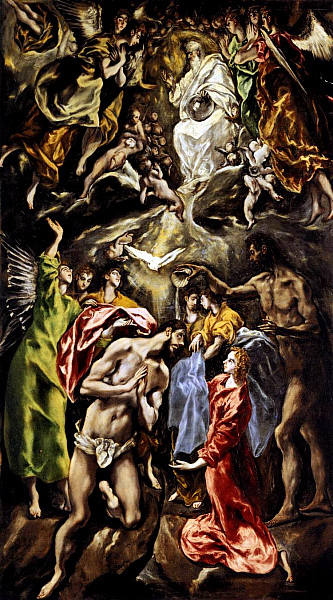Can you be baptized with the baptism with which I am baptized? (Mark 10:38)
The Lord Jesus asked the ambitious Apostles this question. When the Lord referred to “the baptism with which I am baptized,” what exactly did He mean?

—
Christ had already been baptized by John in the Jordan River. Over John’s objections. To the Baptist, it made no sense to wash the perfectly pure Lamb of God. But Jesus insisted. It had something to do with “fulfilling all righteousness.”
When the eager Apostles heard the Lord’s question, then, about being baptized with His baptism, they could hardly have understood Him, since even John the Baptist did not understand. But the sons of Zebedee did not hesitate to shout, “We can!” We don’t know what it is. But we can be baptized with your baptism! And Christ replied: Yes, indeed. You will be.
 Still not clear what He means by His “baptism.” But what He said to calm the whole group a few minutes later helps us to understand.
Still not clear what He means by His “baptism.” But what He said to calm the whole group a few minutes later helps us to understand.
Will you fight among yourselves for prominence in God’s kingdom? Pagans fight with pagans to lord it over pagans. But God did not become man to be served; God did not become man to be prominent. God became man to give His life as a ransom.
Christ underwent His baptism by submitting Himself completely to the will of the Father. Why was the Son of Man was born of the Virgin? To die. His baptism began in the Blessed Mother’s womb, when His soul sang with heavenly verses to the Father, “Behold, I come to do your will.” And His baptism was completed when He finished the song on the cross: “Into your hands, Father, I commend my spirit.”
So: The “baptism” of the Son of God, and His pilgrim life on earth, from beginning to end: These are identical.
What He is asking us, then, is: Can you be baptized with a life of complete submission to the will of the Father?
We can. Christ’s baptism gives rise to our baptism. After Christ’s baptism—which He in no way needed, but endured for our sakes—after His baptism, He rose from the dead. He ascended into heaven. He poured out His Holy Spirit. The Spirit of the risen and triumphant Christ baptizes us, in the sacrament of Christian birth. By water and the name of the Father, Son, and Holy Spirit, we share in the death—and the undying life—of the eternal King. What Christ has done with His human life teaches us the true meaning of our lives.
As we mentioned, when the Apostles assured the Lord that they could share in His baptism, they did not understand what they were saying. Not even close.
But they believed. They believed in Christ Himself. They didn’t know what His words meant. But they did know that if He said something needed to happen, then that would be the best thing for them, no matter what it might be, and that they would understand in due time.
 In other words, the Apostles held the Christian faith in the most elemental, the most profound and simple way; they held it DURING the brief period of history when the Messiah’s work of salvation was still unfolding on earth. While Christ walked the earth, the Apostles needed no creed, nor sacraments of faith, because they simply looked at Christ. They looked at Jesus of Nazareth, the carpenter turned rabbi with tawny skin and a beard—they simply looked at this man, and saw God.
In other words, the Apostles held the Christian faith in the most elemental, the most profound and simple way; they held it DURING the brief period of history when the Messiah’s work of salvation was still unfolding on earth. While Christ walked the earth, the Apostles needed no creed, nor sacraments of faith, because they simply looked at Christ. They looked at Jesus of Nazareth, the carpenter turned rabbi with tawny skin and a beard—they simply looked at this man, and saw God.
In Whom do I put my absolute trust? For Whom would I not hesitate to die, because His power and authority trumps even death? Well, God. This man, Jesus. God.
A week ago Thursday, the Church kept the 50th anniversary of the opening of the Second Vatican Council. Our Holy Father Pope Benedict inaugurated the Year of Faith.
We of course have already begun our study of the teachings of Vatican II. Like no ecumenical council before it, Vatican II taught about the Church. I think we could go so far as to say that Vatican II painted the picture of the Church, with words, like She had never been painted before.
Leonardo da Vinci gave us the Mona Lisa; Vatican II gave us the most beautiful portrait of the Bride of Christ. The Council took everything that St. Augustine and all the other great theologians of old had given us, and made it fresh and new for the Age of the New Evangelization.
We will take some time over the next few months to consider Vatican II’s portrait of the Church. But we can start with this:
The Church = the baptized people who believe—believe that Christ is God, that Christ died and rose again, and that He gives life.